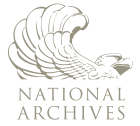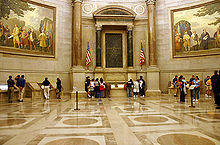| NARA | |

Seal
| |

National Archives logo, a stone eagle inspired by the architecture of the National Archives Building in Washington, D.C.
| |
| Agency overview | |
|---|---|
| Formed | June 19, 1934 (Independent Agency April 1, 1985) |
| Preceding agency |
|
| Type | Independent |
| Jurisdiction | U.S. Federal Government |
| Headquarters | National Archives Building 700 Pennsylvania Avenue NW, Washington, D.C., U.S. |
| Employees | 3,112 (2014) |
| Annual budget | $391 million (FY 2012) |
| Agency executives |
|
| Child agency | |
| Website | www |
The National Archives and Records Administration (NARA) is an independent agency of the United States government charged with the preservation and documentation of government and historical records. It is also tasked with increasing public access to those documents which make up the National Archive. NARA is officially responsible for maintaining and publishing the legally authentic and authoritative copies of acts of Congress, presidential directives, and federal regulations. NARA also transmits votes of the Electoral College to Congress.
The National Archives, and its publicly exhibited Charters of Freedom, which include the original United States Declaration of Independence, United States Constitution, United States Bill of Rights, and many other historical documents, is headquartered in the National Archives Building in Washington, D.C.
Organization
The Archivist of the United States
is the chief official overseeing the operation of the National Archives
and Records Administration. The Archivist not only maintains the
official documentation of the passage of amendments to the U.S. Constitution
by state legislatures, but has the authority to declare when the
constitutional threshold for passage has been reached, and therefore
when an act has become an amendment.
The Office of the Federal Register publishes the Federal Register, Code of Federal Regulations, and United States Statutes at Large, among others. It also administers the Electoral College.
The National Historical Publications and Records Commission
(NHPRC)—the agency's grant-making arm—awards funds to state and local
governments, public and private archives, colleges and universities, and
other nonprofit organizations to preserve and publish historical
records. Since 1964, the NHPRC has awarded some 4,500 grants.
The Office of Government Information Services (OGIS) is a Freedom of Information Act
(FOIA) resource for the public and the government. Congress has charged
NARA with reviewing FOIA policies, procedures and compliance of Federal
agencies and to recommend changes to FOIA. NARA's mission also includes
resolving FOIA disputes between Federal agencies and requesters.
History
The Rotunda of the National Archives Building, where the Charters of Freedom documents are publicly exhibited
Originally, each branch and agency of the U.S. government was
responsible for maintaining its own documents, which often resulted in
the loss and destruction of records. Congress created the National Archives Establishment in 1934 to centralize federal record keeping, with the Archivist of the United States serving as chief administrator. R.D.W. Connor was chosen to be the first leader of the organization.
After a recommendation by the first Hoover Commission in 1949, the National Archives was placed within the newly formed General Services Administration
(GSA). NARA was officially given its independence from the GSA with the
passing of the Records Administration Act of 1984, thus giving birth to
the institution we have today.
In December 1978, millions of feet of news reels were destroyed in a fire at an offsite location in Suitland, Maryland.
The reels, made of exceptionally flammable nitrate material, had been
donated previously by Universal Pictures and were stored in special
vaults to protect against fires. In total over 12.6 million feet of film
was destroyed.
In March 2006, it was revealed by the Archivist of the United
States in a public hearing that a memorandum of understanding between
NARA and various government agencies existed to "reclassify", i.e.,
withdraw from public access, certain documents in the name of national
security, and to do so in a manner such that researchers would not be
likely to discover the process (the U.S. reclassification program). An audit indicated that more than one third withdrawn since 1999 did not contain sensitive information. The program was originally scheduled to end in 2007.
In 2010, Executive Order 13526 created the National Declassification Center to coordinate declassification
practices across agencies, provide secure document services to other
agencies, and review records in NARA custody for declassification.
The National Archives found itself under public scrutiny when it initially agreed, in 2017, to requests from the U.S. Immigration and Customs Enforcement agency (ICE) to allow certain documents be scheduled for destruction.
Records
NARA's
holdings are classed into "record groups" reflecting the governmental
department or agency from which they originated. Records include paper
documents, microfilm, still pictures, motion pictures, and electronic
media.
Archival descriptions of the permanent holdings of the federal
government in the custody of NARA are stored in the National Archives
Catalog. The archival descriptions include information on traditional paper holdings, electronic records, and artifacts. As of December 2012, the catalog consisted of about 10 billion logical data records describing 527,000 artifacts and encompassing 81% of NARA's records. There are also 922,000 digital copies of already digitized materials.
Most records at NARA are in the public domain, as works of the federal government are excluded from copyright protection. However, records from other sources may still be protected by copyright or donor agreements. Executive Order 13526 directs originating agencies to declassify documents if possible before shipment to NARA for long-term storage, but NARA also stores some classified documents until they can be declassified. Its Information Security Oversight Office monitors and sets policy for the U.S. government's security classification system.
Many of NARA's most requested records are frequently used for genealogy research. This includes census records from 1790 to 1940, ships' passenger lists, and naturalization records.
Archival Recovery Teams
Archival Recovery Teams investigate the theft of records.
Facilities and exhibition spaces
The most well known facility of the National Archives and Records Administration is the National Archives Building (informally known as "Archives I"), located north of the National Mall on Constitution Avenue in Washington, D.C.. A sister facility, known as the National Archives at College Park ("Archives II") was opened 1994 near the University of Maryland, College Park. The Washington National Records Center
(WNRC), also located in the Washington, D.C., metropolitan area, is a
large warehouse facility where federal records that are still under the
control of the creating agency are stored. Federal government agencies
pay a yearly fee for storage at the facility. In accordance with federal
records schedules, documents at WNRC are transferred to the legal
custody of the National Archives after a certain time; this usually
involves a relocation of the records to College Park. Temporary records
at WNRC are either retained for a fee or destroyed after retention times
have elapsed. WNRC also offers research services and maintains a small
research room.
Across the United States, the National Archives maintains both
research facilities and additional federal records centers (FRCs). In
many cases, the research rooms of regional archives are located at the
same site as the federal records center, which are inaccessible to the
public.
In April 2019 an unknown person set fire to an exterior wall of
the archives building using a homemade incendiary device before
firefighters were able to extinguish the flames.
Public–private partnerships
In
an effort to make its holdings more widely available and more easily
accessible, the National Archives began entering into public–private
partnerships in 2006. A joint venture with Google
will digitize and offer NARA video online. When announcing the
agreement, Archivist Allen Weinstein said that this pilot program is
... an important step for the National Archives to achieve its goal of becoming an archive without walls. Our new strategic plan emphasizes the importance of providing access to records anytime, anywhere. This is one of many initiatives that we are launching to make our goal a reality. For the first time, the public will be able to view this collection of rare and unusual films on the Internet.
On January 10, 2007, the National Archives and Fold3.com (formerly Footnote)
launched a pilot project to digitize historic documents from the
National Archives holdings. Allen Weinstein explained that this
partnership would "allow much greater access to approximately 4.5
million pages of important documents that are currently available only
in their original format or on microfilm" and "would also enhance NARA's
efforts to preserve its original records."
In July 2007, the National Archives announced it would make copies of its collection of Universal Newsreels from 1929 to 1967 available for purchase through CreateSpace, an Amazon.com
subsidiary. During the announcement, Weinstein noted that the agreement
would "... reap major benefits for the public-at-large and for the
National Archives." Adding, "While the public can come to our College
Park, Maryland, research room to view films and even copy them at no
charge, this new program will make our holdings much more accessible to
millions of people who cannot travel to the Washington, D.C. area." The
agreement also calls for CreateSpace partnership to provide the National
Archives with digital reference and preservation copies of the films as
part of NARA's preservation program.
In May 2008, the National Archives announced a five-year
agreement to digitize selected records including the complete U.S.
Federal Census Collection, 1790–1930, passenger lists from 1820 to 1960
and World War I and World War II draft registration cards. The partnership agreement allows for exclusive use of the digitized records by Ancestry.com for a 5-year embargo period whereupon the digital records will be turned over to the National Archives.
Social media
The National Archives currently utilizes social media and Web 2.0 technologies in an attempt to communicate better with the public.
On June 18, 2009, the National Archives announced the launching
of a YouTube channel "to showcase popular archived films, inform the
public about upcoming events around the country, and bring National
Archives exhibits to the people."
Also in 2009, the National Archives launched a Flickr photostream to
share portions of its photographic holdings with the general public. A new teaching-with-documents Web site premiered in 2010 and was developed by the education team. The site
features 3,000 documents, images, and recordings from the holdings of
the Archives. It also features lesson plans and tools for creating new
classroom activities and lessons.
In 2011, the National Archives initiated a WikiProject on the
English Wikipedia to expand collaboration in making its holdings widely
available through Wikimedia.
Controversy
In
January 2020, a Washington Post reporter noticed blurred protest signs
in a 2017 Women's March image at the Archives' public exhibit. Some of
the signs contained potentially offensive language, some mentioned the
president. Besides censoring language, the edits changed the meaning of
some protest signs. The agency defended the edits were made "so as not
to engage in current political controversy" but admitted it "made a
mistake… we were wrong to alter the image."
Notable crimes
- In 1963, Robert Bradford Murphy and his wife, Elizabeth Irene Murphy were arrested and sentenced to ten years in prison for stealing documents from several federal depositories, including the National Archives.
- In 1987, Charles Merrill Mount was arrested and sentenced to five years in prison for stealing 400 documents from the National Archives.
- In 2002, Shawn Aubitz pleaded guilty to stealing dozens of documents and photographs from the National Archives during the 1990s.
- In 2005, Sandy Berger was charged with an unauthorized removal of documents from the National Archives; sentenced to 100 hours of community service and fined $50,000.
- In 2005, Howard Harner was sentenced to two years in prison and fined $10,000 after stealing 100 documents from the National Archives.
- In 2006, Denning McTague was sentenced to 15 months in prison and fined $3,000 after stealing 164 documents from the National Archives.
- In 2011, Leslie Waffen was sentenced to 18 months in prison after stealing 955 recordings from the National Archives.
- In 2011, Thomas Lowry was permanently banned from the National Archives after he confessed to altering the date on a presidential pardon signed by Abraham Lincoln.
- In 2011, Barry Landau and Jason Savedoff were arrested and sentenced to seven-and-a-half years in prison for stealing ten thousand documents from the National Archives.
- In 2018, Antonin DeHays was arrested for multiple thefts of military artifacts and records from the National Archive during the mid to late 2010s.











